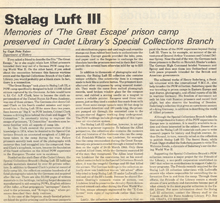This project originated from a desire by Lt. Col. Rod Rice and Prof. Bill Newmiller of the Academy’s English Department to incorporate web writing into the curriculum. Three cadets who gave many hours of labor to the project were Jenn Askins ('98), Chris Backus ('99), and Ed Rivera ('99). Duane Reed and Dr. Mary Elizabeth Ruwell, each previous Chief Archivists of the Academy, gave invaluable help. The Friends of the Air Force Academy thank these talented, dedicated individuals for their invaluable work on this project.
The Clark Special Collections Branch holds a number of interesting and historically significant collections of documents, photographs, diaries, and memoirs. Among the most significant is the collection which tells the story of the Allied airmen who, having been shot down in combat over Europe in World War II, were prisoners of war in Stalag Luft III, the German camp located in Silesia (now Poland). This was the camp that became famous for the Great Escape of March 1944.
This collection, assembled through the efforts of Stalag Luft III Former POW Association, has become a centerpiece of the Academy’s Special Collections. It includes hundreds of photographs, many taken in the camp during the war by clandestine cameras in the possession of the POWs. There are also official photographs taken by the Germans and acquired after the war. Among the many research documents are the memoirs of Colonel Friedrich Wilhelm Von Lindeiner and Major Gustav Simoleit, both of whom served as commandants of this Luftwaffe camp. Also available is the oral history of Hermann Glemnitz, a senior non-commissioned officer in charge of preventing escape.
Another highlight of this remarkable collection is the work of Henry Söderberg, the Swedish volunteer with the International YMCA. He spent much of the war serving the Allied camps in Central and Eastern Europe and kept copious diaries, photographs, and official reports of his life in wartime Germany. Söderberg’s remarkable freedom of movement within Germany enabled him to record a rare picture of the prisoner’s life and that of the German people themselves. He visited the Russian prisoners in their camps and recorded their desperate conditions. Söderberg was also an eyewitness to the bombing of Dresden and served as a volunteer among the ruins helping to save lives.
As early as October 1944, the prisoners of Stalag Luft III learned of the atrocities occurring in Nazi concentration camps from a group of incoming prisoners who had been erroneously sent to the infamous Buchenwald camp. They carefully documented the conditions in the camps and carried their reports at great risk through German searches until the end of the war. Another paper outlines the Germans’ official policy regarding POW escapes. Of great importance are the end-of-war reports written by the respective camp senior American officers, as well as reports of incidents and shootings that occurred in the camps. A number of individual scrap books and works of art done by prisoners also survived the war and are included in the collection.
One of the most remarkable aspects of the collection is that many of the rare documents were carried out of Germany by former prisoners. On Hitler’s direct orders, Stalag Luft III was evacuated on the bitter cold night of January 29, 1945. On very short notice some 11,000 British and American officers were force-marched westward to avoid their liberation by the advancing Russian armies. The fact that these men gathered up this significant historical material andcarried it with them under such difficult conditions is most unusual and reflects their deep sense of history. One officer carried on his back several large ledgers filled with the names and brief accounts of how each of the 2,000  prisoners from South Camp was shot down and captured. Another prisoner from Center Camp brought out a file of weekly camp newspapers.
prisoners from South Camp was shot down and captured. Another prisoner from Center Camp brought out a file of weekly camp newspapers.
The collection began in 1974 with a scrap book compiled by Lt. Gen. A.P. Clark after he retired as Superintendent of the Academy. He was a POW in Stalag Luft III himself and donated his extensive collection of photographs and important documents to the Academy Library. Gradually the collection grew in size and significance.
 The Air Force Academy values this collection highly. It constitutes a rich source of unique historical documents and is widely studied by the Academy’s cadets. Each year a growing number of scholars also use the collection. The experience of the Allied POWs has also been the subject of numerous documentaries which have been carried on national network television.
The Air Force Academy values this collection highly. It constitutes a rich source of unique historical documents and is widely studied by the Academy’s cadets. Each year a growing number of scholars also use the collection. The experience of the Allied POWs has also been the subject of numerous documentaries which have been carried on national network television.





